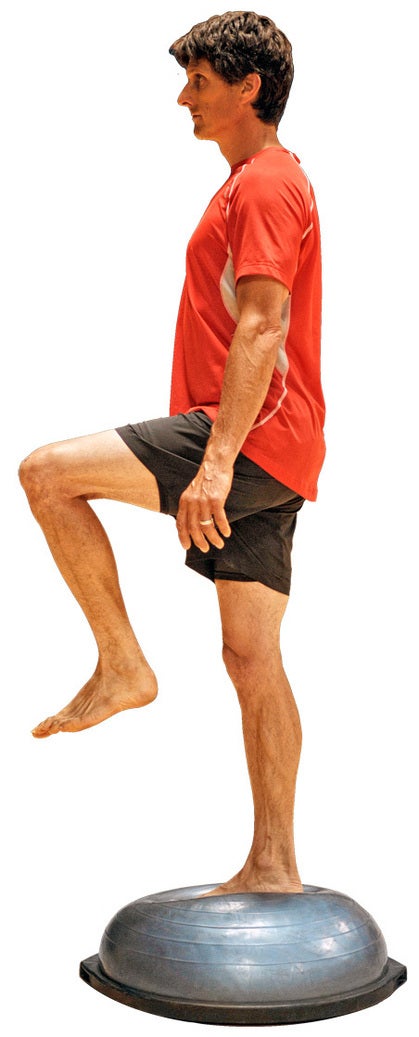Balancing Act

Prevent common injuries with a BOSU Ball
The transition from pavement to trails is exhilarating, but making the common mistake of “too much too soon” …
Photo by Duane Raleigh
The transition from pavement to trails is exhilarating, but making the common mistake of “too much too soon” can cause unwanted injuries — like a sprained ankle, patellofemoral pain or plantar fasciitis. Since our foot is the first thing to hit the trail, and it must respond to constantly changing trail conditions (like rocks, roots or trail embankments) in microseconds, ankle stability is essential for trail running.
Stability is all about controlling movement, or eccentric muscle contraction. This is when muscle fibers are lengthening while contracting (as opposed to concentric, which is when the muscle shortens as it contracts). Eccentric contraction is used for decelerating a body part. Take a bicep curl, for example; as you bend your elbow and lift a dumbbell, your bicep muscle is concentrically contracting, but as you lower the weight back down in a controlled manner, your bicep is eccentrically contracting. If your bicep did not contract eccentrically, it would collapse at your side.
This is the same process that happens to your ankle when your foot hits the trail. It starts to roll toward the inside, and the lateral muscles of you lower leg and ankle decelerate the motion to avoid excessive movement that would otherwise cause an ankle sprain.
Proprioception also plays a role in ankle stabilization. This is the ability to sense the position, location, orientation and movement of your body and its parts. Since your body is constantly having to make immediate small adjustments on the trail, developing good proprioception helps keep your ankles stable.
Great news for a beginner: ankle stability and proprioception can be improved with practice. One of the best pieces of equipment for this is the BOSU (stands for Both Sides Up) ball. The BOSU ball has a solid platform on one side and half of a stability ball on the other. The BOSU forces you to balance on one of two unstable surfaces, challenging the strength and reaction time of your ankle, as well as your core. We’ve included four BOSU exercises and a pre-requisite exercise below. The goal with each is your ability to stay steady, balanced and relaxed.
1. Pre-requisite: Single Leg Balance on Stable Surface (floor)
Begin by balancing on one leg on a stable surface. Your hips should be level, torso upright and arms hanging naturally at your sides. Standing in front of a mirror is ideal so you can see what your body is doing. Try to hold for 30 to 60 seconds. Switch sides.
Make it more challenging: Turn your head from side-to-side, pass a medicine ball around your waist or close your eyes.
2. Single Leg Balance on BOSU
With the flat side down, start by standing with both feet on the BOSU. Once you feel balanced, stand on one leg. Keep your standing leg locked, with your quad engaged and raised leg bent 90 degrees.
Make it more challenging: Turn your head from side to side or pass a medicine ball around your waist, alternating directions. The goal is to be able to do each one of these activities as steady as possible.
Hardest: Perform exercise on flat side of BOSU, with ball side down.
3. Weight Shifting on BOSU
Start with both feet on the ball side of the BOSU, flat side down. Shift your weight forward onto your toes and then back toward your heels, increasing your forward and backward motion without falling.
Make it more challenging: Stand on one leg. Rock back and forth for 30 to 60 seconds on each foot.
Hardest: Perform exercise on flat side of BOSU, with ball side down.
4. Pistols on BOSU
Start by standing on one leg on ball side of the BOSU, with standing leg quad engaged and raised leg extended as close to 90-degrees as your flexibility allows. Bend your standing knee 30 to 45 degrees and then return to standing. As you squat, sit back slightly, like sitting in a chair, to engage your glutes. Perform two to three sets of 15 reps on each side.
Make it more challenging: Try to squat further than 45 degrees or hold a medicine ball while you squat.
Hardest: Perform exercise on flat side of BOSU, with ball side down.
5. Ball Toss on BOSU
Start by standing on one leg on either side of the BOSU. With a partner, toss a ball back and forth for 60 seconds on each leg.
Make it more challenging: Have your partner throw a ball slightly to the side or down low so you are forced to react quickly to catch it. (If you don’t have a partner, throw ball against a wall.)
If these exercises seem difficult at first, it just means its even more important for you to be doing stability work.
Erika Lindland is an orthopedic physical therapist in Fairfax, California, and certified strength and conditioning specialist who works primarily with runners. She is also an ultrarunner and the owner of the online trail running store www.MarinTrailRunning.com.